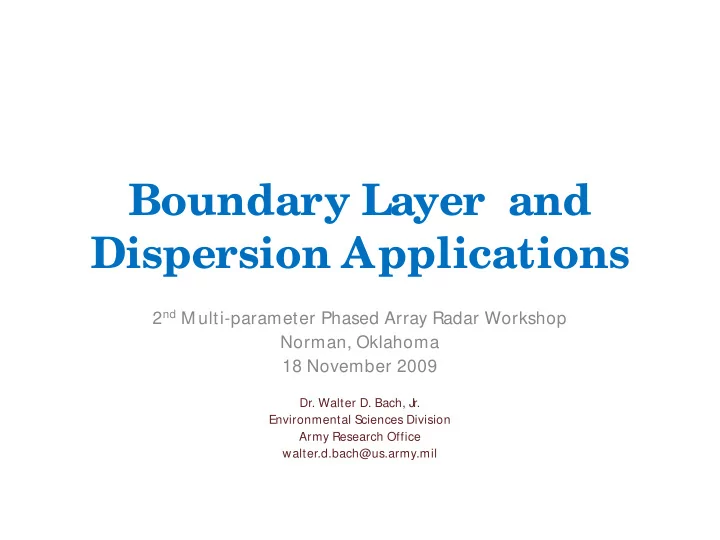

Boundary Layer and Dispersion Applications 2 nd M ulti-parameter Phased Array Radar Workshop Norman, Oklahoma 18 November 2009 Dr. Walter D. Bach, Jr. Environmental Sciences Division Army Research Office walter.d.bach@us.army.mil
Outline • R&D Needs / Priorities – M P AR – NRC Report : From the Ground Up – OFCM J AG/ Atmospheric Transport And Diffusion • PBL Science issues • Key Challenges
MPAR R&D Needs / Priorities • • Weather Surveillance Other Surveillance – Real time Severe Weather – Airborne release of toxins – Nowcast Airport Wind – Spaceflight ops Hazards – Ground truth satellites – Enroute ice and turbulence – Fire Weather / Wildland – Heavy precipitation Fires – Hydrometeorology – M udslides – Initialize NWP wind models – Air Quality and Health and near PBL – Volcanic Ash – Birds as Hazards – Agriculture • Aircraft Surveillance – Cooperative – Non-cooperative
NRC O Obs bservations Sup Supporti ting Fundame mental al In Infras astruct cture f for Mes esoscal ale Monitorin ing and and Predic ediction • Phenomenology for Observational Requirements – T emperature, moisture, and wind velocity universally required – M ost requirements below 5 km (deepest PBL) – Smaller scale phenomena need high resolution • Data Assimilation: Synergy of Data and M odels – M easurement error – Representativeness error – M odel physics • Special Climate Requirements – Absolute accuracy – Long term • M esoscale Observations for Research – Research obs are often episodic, ephemeral, and of limited area tending to focus on details of processes. (They) may fail to contribute reliably or consistently to ongoing operations and therefore could be viewed as untrustworthy, disruptive, or even parasitic.
NR NRC R Recom ommend ndations ons • M easurements and Infrastructure – Lidar and radar profilers for lower troposphere – 400 – Air Quality Sensors – CO, SO 2 , O 3 , 2.5 µ m aerosols - 200 in urban; 175 km rural separation – Soil moisture and temperature profiles - 3000 – Distributive/ collaborative networks of radar and lidar – GOES based water vapor & temperature profiles in Continental boundary layer – Upgrade rail / ground transportation systems to WM O standards – Facilitate observational network of Vehicle Infrastructure Integration initiative
NRC R C Repo port • Nearly all recommendations for improving the mesoscale observations address BL issues. Few address modeling issues. • Network site recommendations (~ 125 km separation) adds finer structure to larger scale features through data assimilation, but are too coarse to address BL heterogeniety issues. • M easurements, M odeling, and Use should be designed to work together – within a test bed network concept as recommended by the J AG/ATD and as J AG/JUTB is developing
JAG/ G/ Atmos osph pheric T c Transpor ort a and Diffus usion on R&D &D Strat ategy to y to Meet U t User N r Needs Interpret Uncertainty GOALS Routinely Quantify Uncertainty CAPTURE AND USE EXISTING M ODEL EVAL STANDARDS M EASUREM ENT SITING BRIDGE THE SCALE M EASUREM ENT LOCAL/ REGIONAL DATA SETS ABILITIES ATD TEST BEDS GAP OBJECTIVES CAP COORDINATED AGENCY SUPPORT & FUNDING
Model el G Grid id Siz Sizes DNS LES GCM GAP M esoscale CFD Physical M odeling Building Urban Storm Fronts Synoptic 1 mm 1 cm 1 m 10 m 100 m 1 km 10 km 100 km 1000 km Horizontal grid spacing
Meas easur urem ement Capa Capabilities at at Model el G Grid id Spac Spacin ing Diurnal Boundary Layer Rawinsondes RADAR ACARS M eso-Net M odeling Gap Surface Layer Surface Obs Building Urban Storm Fronts Synoptic 1 mm 1 cm 1 m 10 m 100 m 1 km 10 km 100 km 1000 km Horizontal grid spacing
PBL Sc PBL Scie ience e Issues ues • Smallest scales of atmospheric motion affected by all larger scales • M ajor energy exchange • M ost variable, least predictable part of atmosphere. • Few measurements near ground; fewer aloft. Difficult to characterize existing measurements • Forecast models are too coarse for local accuracy – PBL heights – Stability – Shear – Large rms wind direction error • PBL models (turbulence closure, dispersion) have large uncertainty and large effects from small changes (chaotic).
Key C Challen lenges es • Close the knowledge gap between the mesoscale and microscale modeling capabilities Observations M odels Theory • Develop instrumentation for measuring PBL wind, temperature, and moisture at PBL time & space scales (smaller than models) • Operate instruments in high impact networks covering 50 x 50 km footprint continuously. • Quantify uncertainty in model inputs and predictions • Represent transport and diffusion in complex flows, including urban and coastal environments
Que s tions Comme nts
Positive Negative • Data assimilation of • M odel Development winds • Uncertainty • Increased space-time resolution
Recommend
More recommend